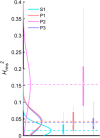Coral reef structural complexity provides important coastal protection from waves under rising sea levels
- PMID: 29503866
- PMCID: PMC5829992
- DOI: 10.1126/sciadv.aao4350
Coral reef structural complexity provides important coastal protection from waves under rising sea levels
Abstract
Coral reefs are diverse ecosystems that support millions of people worldwide by providing coastal protection from waves. Climate change and human impacts are leading to degraded coral reefs and to rising sea levels, posing concerns for the protection of tropical coastal regions in the near future. We use a wave dissipation model calibrated with empirical wave data to calculate the future increase of back-reef wave height. We show that, in the near future, the structural complexity of coral reefs is more important than sea-level rise in determining the coastal protection provided by coral reefs from average waves. We also show that a significant increase in average wave heights could occur at present sea level if there is sustained degradation of benthic structural complexity. Our results highlight that maintaining the structural complexity of coral reefs is key to ensure coastal protection on tropical coastlines in the future.
Figures




References
-
- Hearn C. J., Wave-breaking hydrodynamics within coral reef systems and the effect of changing relative sea level. J. Geophys. Res. Oceans 104, 30007–30019 (1999).
-
- Monismith S. G., Rogers J. S., Koweek D., Dunbar R. B., Frictional wave dissipation on a remarkably rough reef. Geophys. Res. Lett. 42, 4063–4071 (2015).
-
- Dickinson W. R., Pacific atoll living: How long already and until when. GSA Today 19, 4–10 (2009).
Publication types
LinkOut - more resources
Full Text Sources
Other Literature Sources

